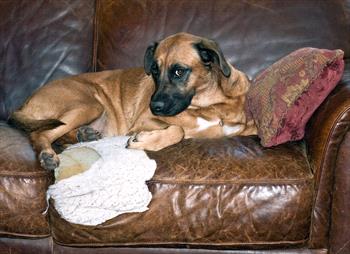Couch chewed by dog

Photo courtesy of Depositphotos
Dogs are highly social, and most dogs thrive best when they have company. Being alone results in separation anxiety and other separation-related behaviors for many dogs.
How do I know if my dog has separation anxiety?
Signs of separation anxiety include increased barking, howling, whining, destructive behaviors, and having “accidents” in the house. Many dogs with separation anxiety are very attached to a person or persons (this is sometimes called “Velcro dog” because they’re so clingy), but not all Velcro dogs have separation anxiety. Velcro dogs are often overjoyed when you come home and look “sad” or “depressed” when you leave. Separation anxiety is like a panic attack in a person and can damage the quality of life for both dog and human.
I think my dog has separation anxiety what do I do?
The first step if you suspect separation anxiety is a trip to your vet. Some medical conditions and other behavioral conditions can look like separation anxiety. Many dogs with separation anxiety have more than one behavior problem which can complicate diagnosis and treatment. Video of your dog when home alone will help your veterinarian with diagnosis and monitoring treatment. If you don’t have a web camera, you can leave a cell phone on record while you are gone for short trips.
What causes separation anxiety?
Changes in the home or peoples’ schedules can cause separation anxiety. Examples include a recent move, spending more time with the dog while on vacation or because of illness, death in the family, or death of another pet. Some dogs have trouble being alone from a very early age and develop separation anxiety despite never going through any major events. It is common for dogs from shelters and dogs with single adult owners to have some separation anxiety. Dogs can be any age when separation anxiety appears. If left untreated, the condition tends to get worse.
How do you treat separation anxiety and other separation-related behaviors?
Treating separation anxiety can be tough. Why? Because the behavior mainly occurs when your dog is home alone away from you. So, you’re not there to help your dog. For some dogs, anxiety begins before you even leave the house, with the start of your morning routine. There are even dogs who can tell the difference between workdays and days off and are only anxious on workdays.
Treatment often involves a combination of medications and behavior modification. Medication alone is never the answer.
Step 1: Medications are often needed
We first must treat your dog’s emotional state before we can help them learn to cope better alone. This treatment often involves a long-term medication and short-term medication in the beginning. Often the earlier you start medications the more successful treatment will be.
In the United States, two medications are approved to treat separation anxiety in dogs. They are called Reconcile (fluoxetine) and Clomicalm (clomipramine). Though effective and with few side effects, these medications can take 4-8 weeks to fully work. These medications are often combined with shorter-acting drugs such as trazodone, gabapentin, clonidine, or alprazolam to achieve rapid results and address the panic component when people first leave. Medication should not be expected to work by itself. Medication should always be combined with behavior modification.
Clomicalm (Clomipramine)
Clomipramine, a tricyclic anti-anxiety drug, works by increasing levels of serotonin in the brain. Serotonin is a neurotransmitter associated with pleasant, relaxed sensations such as eating chocolate, sun-bathing, and falling in love. When serotonin levels are high, we feel good and sleep better. Clomipramine may be used once or twice a day.
Reconcile (fluoxetine)
Fluoxetine is more commonly known by its human brand name Prozac®. Like clomipramine, it increases serotonin levels. It is usually given once daily along with behavior management. It can take several weeks to see a meaningful change, although some dogs respond more quickly.
Trazodone, Clonidine, Gabapentin, Alprazolam
Fast-acting medications are used to treat actual panic. They are often used only until the long-term medications start to work. Diazepam, more commonly known as Valium®, might be useful in such a situation but it won’t last long enough to cover several hours of owner-pet separation and causes sedation. Alprazolam (Xanax®), a similar drug that lasts longer, so it may be a better choice in this situation depending on how long the dog is left alone and how anxious she is. Both these drugs are controlled, meaning paperwork must be filed with the government in order to prescribe them. Local laws may limit the number of tablets that can be obtained. Also, if used regularly, these drugs can cause tolerance (need higher doses to see the same effect) and dependencies (addiction) There are also concerns about using these drugs in dogs who show any aggression. Even mild aggression like barking or growling at a person or other animal can get worse while the dog is taking these drugs.
Trazodone is another short-acting serotonin enhancing medication that can help some dogs with separation anxiety. Trazodone is given 90 minutes before people leave and can be repeated 8 hours later if people are going out again. Other medications such as gabapentin (also given 90 minutes before leaving) and clonidine (given 30-60 minutes before departure) may also lower the panic that happens when people first leave.
Over the Counter Products (Nutraceuticals with ingredients like l-theanine, tryptophan, hydrolyzed milk proteins, synthetic pheromones, and probiotics)
Used alone, these products are rarely helpful for animals with severe anxiety. Some of these products have small research studies to suggest that they may be helpful, especially for mild to moderate anxiety. Most importantly, they are unlikely to cause problems. These over the counter products are frequently more expensive than the prescription medications listed above. Your veterinarian may recommend adding them to the drug regime when the pet is doing well to see if anxiety can be reduced further without adding more pharmaceuticals.
Step 2: Avoidance
Avoid leaving your pet home alone until the medications have time to work. Taking your dog to work, hiring a dog sitter, or taking your dog to stay with friends will reduce the time your dog spends alone and anxious. Some dogs even do well in the car as long as it is not too hot or too cold.
If you do have to leave your dog alone, don’t come and go. Dogs with separation anxiety often have panic attacks when people leave them. If you forget something, don’t go back to get it. If you have several errands, do them all in one trip. Run errands right after work; don’t come home and go out again. If a dog walker is coming in the middle of the day, see how your dog does without that extra walk. Many dogs with separation anxiety do better if they don’t have to deal with extra time seeing a person leave.
Step 3: Food dispensing and Puzzle toys
Food dispensing and puzzle toys such as snuffle mats, Kongs, West Paw puzzle toys, and others can help reduce your dog’s overall stress level. They encourage the dog to play and solve problems without help from people. This can help the dog to be more independent. Many dogs may be too anxious to eat when they are alone. Feeding all meals out of these devices can keep your dog from seeing these toys as a sign that you’re going to leave.
Step 4: Create a Relaxing Environment
A safe haven will help your dog feel safe even when you are not at home. Make sure all good things happen in this place. Encourage your dog to retreat here throughout the day, when you are not leaving, for special treats and rewards. To reduce stimulation and anxiety, avoid outside windows or doors in this safe place. Classical music or audiobooks can soothe your pet. Be careful about talk radio and tv as these can have a stimulating effect.
If your dog is not comfortable being in a crate, do not use a crate as the safe haven. Many dogs with separation anxiety are more anxious if they are confined in small spaces. Dogs can injure or even kill themselves trying to escape from crates.
Step 5: Make Sure Your Dog’s Basic Needs are Being Met
Exercise can help some dogs with separation anxiety, but make sure you are not overdoing it. Daily exercise with sniff walks (just walk along and let your dog sniff), games where they find hidden toys or treats or playing with other fun toys like a flirt pole (fleece toy on the end of a bungee cord for the dog to chase and catch) can give your dog exercise and mental stimulation while building the relationship between you and your dog. In other words, find things you enjoy together to reduce tension and stress in everyday life.
Step 6: Independence Exercises
Teaching your dog to feel safe alone is the mainstay of the separation anxiety treatment plan. There are various ways to do this:
- Giving your dog a food dispensing or puzzle toy before walking out of the room can keep your dog busy as you leave
- Teaching your dog to “go to” and relax on a mat. You first train this while you’re right there next to the dog. Once the dog is comfortable staying on the mat you gradually move further away from you. For most dogs it takes many sessions to build up to the do staying while the person moves out of their sight. It’s important to go slowly with your training so your dog sees this as a fun game and never gets worried about what’s going on.
- Asking your dog to do something, such as sit or lie down, before you give your dog rewards like food, toys, attention, and access to favorite spaces (i.e. bed and couch) can help establish a relationship that is consistent and predictable which reduces overall anxiety.
Step 7: Absolutely No Punishment
DO NOT PUNISH YOUR DOG

Photo courtesy of Depositphotos
Punishment can take on many forms and meanings. Yelling, spraying water, physical corrections, like spanking or holding the dog down, bark collars, shock collars, vibrating collars, and even saying “no” could all be considered punishment. Remember, it’s how the dog responds to something that determines if it’s a punishment, not what you meant it to be. Some dogs are also more sensitive to punishment or corrections than others.
When your dog is destructive, eliminates, or barks when you are gone, they aren’t angry or spiteful. They want to reunite with you, break down barriers, and feel safe. Or they are having accidents because they are so anxious they can’t control themselves. Punishment makes anxiety and fear worse. Even if punishment seems to work, if the dog is still anxious you can see other problems. For example, a dog may stop barking while wearing a bark collar but start to urinate in the house.
What about Planned Departures?
Planned departures (also known as gradual departures – leaving for a short period of time) may or may not help. In many cases, attempting to reduce separated-related behaviors through gradual departures makes the dog more sensitive to being alone. If your dog’s anxiety is not already reduced with medication or you move too quickly through the process, you may soon be back to square one in the whole treatment process.